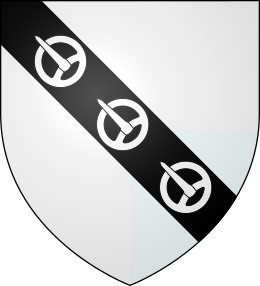Clan Stirling facts for kids
Quick facts for kids Clan Stirling |
|||
|---|---|---|---|

Crest: Issuing out of an antique coronet Or a hart's head couped Azure
|
|||
| Motto | Gang Forward | ||
| Profile | |||
| Region | Lowlands | ||
| District | East Dunbartonshire Stirlingshire Perthshire | ||
| Chief | |||
 |
|||
| Francis Stirling of Cadder | |||
| Chief of the Name and Arms of Stirling | |||
| Seat | Oakley Street, London SW3 | ||
| Historic seat | Cadder House | ||
|
|||
|
|||
Clan Stirling is a historic Scottish clan from the Scottish Lowlands. A clan is like a large family group, often with a shared history and a chief. The Stirlings have a long and interesting past, with many members playing important roles in Scottish history.
Contents
History of Clan Stirling
Where Did the Name Stirling Come From?
The name Stirling comes from the town of Stirling in Scotland. This town and its famous Stirling Castle were very important. They were like a crossroads for Scotland. The name Stirling might mean "place of struggle" or "strife."
The first known Stirling was Thoraldus. He lived around the year 1147. He owned land called Cadder. Later, one of his family members, Alexander de Strivelyn, was the fifth owner of Cadder. He passed away in 1304.
Fighting for Scottish Freedom
During the Wars of Scottish Independence, a big fight for Scotland's freedom, a Stirling family member was very brave. Sir John de Strivelyn, who was Alexander's heir, died in the Battle of Halidon Hill in 1333. He fought to protect Scotland's independence.
Important Stirlings in the 1400s and 1500s
Sir John de Strivelyn's grandson was Sir William. Sir William had two sons. The family leadership passed down through his oldest son, also named William, for four generations.
Later, the leadership went to a grandson of the second son. This was Sir John de Strivelyn, the third owner of Cragernard. Sir John was very important. He was the governor of the royal Dumbarton Castle. He was also the sheriff of Dumbartonshire.
James I of Scotland chose Sir John to be in charge of the Royal Household. He was also the king's armour bearer. Sir John was made a knight in 1430.
His son, William, gained new lands called Glorat from the Earl of Lennox. William also held Dumbarton Castle. This important job then went to his son, George. George bravely defended the castle for the king from 1534 to 1547. George also fought in the Battle of Pinkie Cleugh. Sadly, he died from his wounds after this battle.
In 1581, there was a conflict between Clan Stirling and Clan Kincaid.
The 1600s and Civil War Times
George's great-grandson was Sir Mungo Stirling of Glorat. Sir Mungo was a strong supporter of King Charles I. The king recognized Sir Mungo's bravery and made him a knight.
Sir Mungo's son was George Stirling. In 1666, George was given a special title: Baronet of Nova Scotia.
Another branch of the family, the Stirlings of Keir, got their lands in Perthshire in the mid-1400s. Sir William Stirling of Keir supported Prince James. Prince James was the son of James II of Scotland and had rebelled against his father.
Sir William Stirling's descendant, Sir Archibald Stirling of Keir, was a well-known lawyer. He supported the king during the Scottish Civil War. When the monarchy was brought back in 1660, he continued his support. The Stirling of Garden family branch comes from Sir Archibald Stirling. He was also appointed to Scotland's highest court. His third son, James Stirling (1692–1770), became a famous mathematician.
The 1700s and Jacobite Risings
During the Jacobite rising of 1715 and the Jacobite rising of 1745, the Stirling Lairds of Keir fought for the Stuart family. They wanted the Stuarts to be kings again.
James Stirling of Keir was put on trial for treason. This was because he supported James Stuart's attempt to invade Britain in 1708. But James Stirling was found innocent. His lands were taken away after the 1715 rising, but he got them back later.
Walter Stirling of Faskine served in the Royal Navy. He became the commander-in-chief of the fleet for George III of Great Britain. The Stirling of Faskine family branch was related to the Stirlings of Cadder.
James Stirling of Drumpellier fought in the war against America in 1812. He later became the Governor of Western Australia.
Modern Stirling History
The Stirling family has a long connection with Dumbarton Castle. In 1927, Sir George Stirling of Glorat was made the keeper of the castle.
Sir David Stirling was from the Stirling of Keir family. He was very important in World War II. He founded the British special forces regiment, the Special Air Service (SAS).
Clan Chief
The current chief of Clan Stirling is Francis Stirling of Cadder. He is known as the Chief of the Name and Arms of Stirling.
Clan Castles
Many castles and houses have been important to Clan Stirling throughout history:
- Cadder Estate was the very old home of the Clan Stirling chiefs.
- Drumpellier House
- Keir House
- Dumbarton Castle: Several Clan Stirling chiefs were sheriffs of Dunbarton from the 1400s onwards.
- Glorat House: This was the home of the Stirlings of Glorat.
Spelling Variations
The name Stirling can be spelled in many different ways. Here are some examples: Staereling, Stairline, Stairling, Starlin, Starling, Stairlink, Sterline, Sterling, Sterlink, Sterlline, Sterlling, Sterllink, Steuline, Steuling, Steulink, Stewline, Stewling, Stewlink, Stirine, Stiring, Stirink, Stirline, Stirling, Stirlink, Strifelan, Strifeland, Strifelane, Strifelant, Strifelen, Strifelend, Strifelent, Strifelind, Strifelint, Strifelyn, Strifelynd, Striffelan, Striffeland, Striffelane, Striffelant, Striffelen, Striffelend, Striffelent, Striffelind, Striffelint, Striffelyn, Striffelynd, Strivelan, Striveland, Strivelane, Strivelant, Strivelen, Strivelend, Strivelent, Strivelind, Strivelint, Strivelyn, Strivelynd, Sturline, Sturling, Sturlink, Styrline, Styrling, Styrlink.
See also
- Scottish clan
- Stirling baronets

